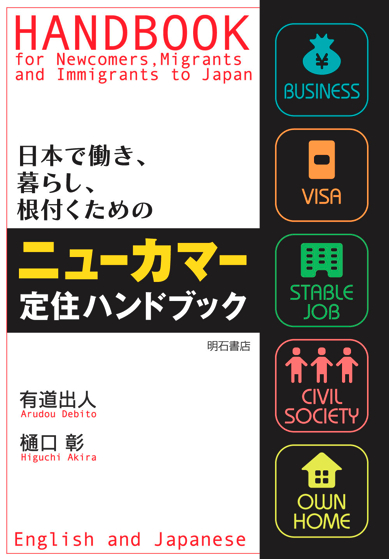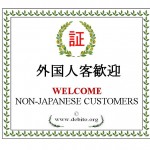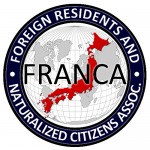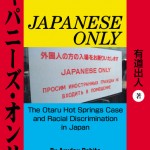mytest






![]()

UPDATES ON TWITTER: arudoudebito
DEBITO.ORG PODCASTS now on iTunes, subscribe free
Hi Blog. Eurobiz Magazine a couple of months ago ran an article talking inter alia about something I’ve called the “Gaijin Tax” for more than a decade now — the Re-Entry Permit system. Thought of by some as a way of punishing the Zainichi Koreans etc. for staying behind in Japan (given all the incentives for them to leave after being stripped of colonial Japanese citizenship, moreover registered as foreigners in the late 1940’s), the Re-Entry Permit actually is a tax with a profit motive — even the lecturer cited by Tony McNicol below states this openly about its proposed abolition:
Without re-entry permit income, currently ¥6,000 for multiple re-entry, the changes are likely to lighten the government’s coffers. “This is a huge reduction in our revenue,” said Matsuno. “The Ministry of Finance is angry.”
What a piece of work our government can be. Charging for visas for foreigners and passports for nationals is one thing (and I just paid 16,000 yen for a new ten-year Japanese passport; ouch). But charging foreigners for their addiction to going “home” (or for even daring to leave Japan) with their visa held hostage, well, that’s just as I’ve suspected all along — a mean-spirited means to sponge off the NJ population. Good riddance to it. Arudou Debito
//////////////////////////////////////////////////////////
Eurobiz Magazine August 2010
Your new alien registration card
Changes under the new Japanese immigration system
http://www.eurobiz.jp/content/2010/august/columns/event-report
By TONY MCNICOL, courtesy of the author
Applying and paying for a re-entry permit has long been an unavoidable nuisance for foreign businesspeople traveling out of Japan. But during a recent EBC organised event at the EU-Japan Centre for Industrial Cooperation it was announced that the “gaijin tax” will soon be no more. It was just one of a raft of changes to the law explained to attendees by Hiroaki Matsuno, a deputy director at the Ministry of Justice.
The government plans to bring the revised regulations into force by July 2012 at the latest, and the Ministry of Justice is already busy at work on the details. Matsuno, who took up his current post a few months ago, has been working till midnight almost every day, he said.
The biggest change is that, rather than two tiers – immigration bureau for visas and local ward or city office for alien registration cards – everything will now be handled by the Ministry of Justice. For the first time, mid- to long-term foreign residents will come under the juminhyo (residence registry) system; good news for legal foreigners, but bad news for illegals who will not be able to receive the replacement for the current alien registration card – or services such as government healthcare.
In principle the new “residence card”, which will basically replace the “status of residence” stamp in passports, will be issued at the airport at the time of landing. “But we can’t afford to place machines at all of Japan’s airports,” stressed Matsuno. (Japan currently has over 80 airports). For those arriving in the boondocks, the card will be sent by post.
For some changes to details on the card, say a change in employer, reporting to the immigration bureau will be required by law. The ministry is investigating the use of proxies, said Matsuno, but has not yet made a decision. The ministry is also considering allowing notification by post or through the internet.
Hopefully, the changes will reduce work for the immigration bureau and shorten queues in their offices (a relief for those who have run the gauntlet of the Shinagawa bureau). “We have been very sorry to keep people waiting,” said Matsuno. Most visa categories will be extended from three to five years, and the residence card will expire after the same period. There will also be a change in the re-entry permit. Mid- to long-term foreign residents will now be exempt from needing a re-entry permit as long as they re-enter Japan within 12 months. (The re-entry permit system will remain for other cases.)
Without re-entry permit income, currently ¥6,000 for multiple re-entry, the changes are likely to lighten the government’s coffers. “This is a huge reduction in our revenue,” said Matsuno. “The Ministry of Finance is angry.”
Rest of the article at
http://www.eurobiz.jp/content/2010/august/columns/event-report
19 comments on “Eurobiz Magazine’s Tony McNicol on the future abolition of the “Gaijin Tax” Re-Entry Permits”
Good to see the “tax” is going, but I’d suggest that they’ll re-coup the money by re-assessing the current visa fees, they are currently very cheap comparatively.
Well, if the Japanese people knew, that we contribute so much to Japanese coffers, they might be more appreciative. Most of them, unfortunately, do not even know about the re-entry permit system and think, we just get our passports checked / stamped when we leave, and when we come back, just like them…
It would be a good idea to keep a close eye on any attempt to increase Visa fees. I am sad to report that in the UK Visa fees for a foreign spouse or dependent entering the country can now be anything from £500 (¥65,000) to £1500 (¥200,000)! Just a few years ago it was a tiny fraction of this.
The biggest change is that, rather than two tiers – immigration bureau for visas and local ward or city office for alien registration cards – everything will now be handled by the Ministry of Justice. For the first time, mid- to long-term foreign residents will come under the juminhyo (residence registry) system; good news for legal foreigners, but bad news for illegals who will not be able to receive the replacement for the current alien registration card – or services such as government healthcare.
There are a bunch of things wrong with this paragraph.
1) There are actually three tiers in the system right now. Foreign Affairs issues visas, Justice issues landing and extension permits, and city hall issues alien registration cards.
2) Under the new system, there are still three tiers. The mandatory ID card switches hands from city hall to Justice, but foreigners still need to register for the juminhyo at city hall.
3) Even though Justice issues the zairyu card, the juminhyo is controlled by city hall. Unless the law clearly says that you need a zairyu card before getting a juminhyo, illegals would be able to get a juminhyo so long as the city allowed it, and this would likely be enough in itself to get many government services.
“Most of them, unfortunately, do not even know about the re-entry permit system and think, we just get our passports checked / stamped when we leave, and when we come back, just like them…”
So true. Most don’t even know about visas. I remember having to explain to the father-in-law what this was- he had no idea. I then resisted launching into my visa diatribe about how foreigners in Japan essentially have to abide by more laws than Japanese people do, and that a chunk of ‘foreign crime’ is actually visa violations.
The fact that we are not even on the juminhyo is also beyond a lot of Japanese people’s knowledge. The past year, I had to explain to insurance agents and car salesmen that I can’t provide them with a juminhyo because I wasn’t on it, i.e., my existence wasn’t recognized. They seemed confused and a little embarrassed.
Assuming everything in the article comes to fruition, good news I guess.
Will believe it when I see it. Governments don’t willingly give up this kind of revenue.
Wonder if this means I will also be able to walk through the same immigration line with my son and wife when re-entering Japan?
The ¥6,000 for multiple re-entry permits is just a rip-off. The Ministry of Finance may be angry, but it should rather start looking for other sources of revenue. What is the \6,000 for? For issuing a re-entry permit? Then why does a single re-entry permit just cost \3,000, although it takes the immigration office exactly the same time to issue?
Also, for the \3,000 or 6,000, there is no service at all. For example, my city hall sent me a letter this summer to remind me that my alien registration card was about to expire. Did I have to pay anything to get a new card? No, it was free. On the other hand, does immigration send me a letter before my visa or my re-entry permit expires, although I paid for it? No, they don’t.
Another point that has been mentioned here is about the alien registration card. I think that local governments don’t actually issue these cards, but just handle the paperwork. On my card, “Ministry of Justice Japan” is clearly printed, so I guess that the ministry issues the cards. That means that the ministry does have all my data anyway.
Hey, the re-entry permit does get you through immigration at the airport faster than anyone else, even Japanese citizens. I’d pay a lot more than 6,000 yen for that perk!
Wonder if this means I will also be able to walk through the same immigration line with my son and wife when re-entering Japan?
You can already. Just take them through the re-entry permit holders’ line with you. That’s what I do.
Which leads to the question, if there’s no re-entry permit, which line will we end up using? I kind of like the re-entry permit line, because it’s shorter than the others.
Iago, that’s not true in all cases. It’s a lottery. Some immigration officers refuse your Japanese spouse when she tries to come through the racist fingerprint line with you, and send them to queue with all the other members of the Master Race.
It says the new cards will be issued upon arrival. But what about people already here now? Where do we go to get one when our current cards expire?
How much do similar permits in other countries cost?
I can’t imagine it being free in America.
I dont know about reentry permits in the U.S., or even if its required, but to get a I130 visa for the wife is now something like 400 USD or more. Keeps going up every year it seems, but you cant even get a live person on the phone at the embassy to answer questions.
— Remember, a Re-Entry Permit is not a visa. It’s a bribe to keep your current visa status alive while you’re outside Japan.
So prices of visas in other countries are a different topic. Find a comparable document in another country to the REP (if there is one) and tell us the price.
US$385 for a US re-entry permit for a permanent resident, but you only need one for an extended stay outside the country (e.g. > 1 year). For shorter trips, free to travel in and out on the basis of your passport plus green card…
Russia requires a re-entry permit. I don’t remember the cost.
I worked at a university there and my boss told me to not leave the country during my vacation
I didn’t have a re-entry permit, and getting one was a pain because it took time.
So, at least in Japan, immigration offices aren’t so far away.
In the sunny desert of Saudi Arabia a single-use re-entry permit is SAR 200 (JPY 4,500) and a multi-use SAR 500 (JPY 11,000), and they each need your sponsor’s written OK to issue. They are valid for a maximum of six months, and carry a fine to your employer/sponsor if they’re not used. Same goes when you leave KSA for good. A final exit visa is issued, and fines to your employer ensue, along with an exclusion order against the individual, if it’s not done properly. A twist on this is that your sponsor/employer retains your passport while you’re in KSA, and usually exchanges it for your ARC (iqama) while you have your passport, and then the reverse happens when you return. It seems to work, with some hiccups. Unlike Japan, about six million of the total population of twenty-six million +/- are non-Saudi. They know that without help from outside the country doesn’t function. At all. It’s not perfect, but it seems to work. With some hiccups. (Eid-Mubarak to debito.org readers!)
Why does anyone need a reentry permit?
Just hand in your gaijin card when you leave Japan, then come back and get a new one (for free) from city hall.
Note: this probably will only work if you are on a spouse visa, on a work visa it may be more difficult…?
To Zac:
When you hand in your card on a work/student visa, they assume that your visa usage period is over (ie. don’t need it any more because you will no longer do whatever it was for) and usually a.) deactivate it by computer if it’s one of those big, fancy stickers or b.) stamp USED across the top if it’s one of the small, plain ones. This essentially means that when/if you ever come back, it will be on some new visa, because your current job/school period has ended.
Obviously, it is probably different for spouse visa holders, since hopefully your marriage does not end simply because your visa does, due to leaving without keeping your visa active (by the re-entry stamp).
And if it really does disappear, good riddance. Nothing like deciding to go overseas last minute and then realizing you can’t because you forgot to take a day off from work to stand in line for a 6000 yen piece of paper…
— For the record: If you leave Japan without a Re-Entry Permit, your visa, for just about every case, resets. That includes people on Spouse Visas. You will start the Status of Residence process again from zero and come back in on a Tourist Visa. Otherwise there wouldn’t be much compulsion behind the REP.